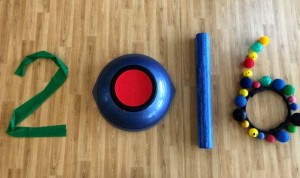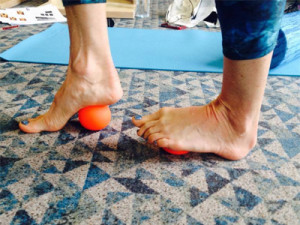Pilates Props – Help or hinder? Challenge or complicate?
 Are Pilates props designed to make a movement more challenging or complex? Or are they there to assist the client in a Pilates session? Better still do they help a client connect with a movement?
Are Pilates props designed to make a movement more challenging or complex? Or are they there to assist the client in a Pilates session? Better still do they help a client connect with a movement?
Most Pilates instructors will say props are used to make a movement more challenging, complex or to add variety, but let us think deeper. Why did Joseph Pilates invent the Pilates apparatus? Why did he add in small props? Pilates was a genius—he understood the human body and when a client exhibited a specific need he developed a tool (prop or piece of apparatus), to address this need.
Joe Pilates created the mat repertoire for himself as a means to get fit, strong and flexible. He was an athletic young man and went on to become quite an accomplished gymnast, martial arts specialist and boxer. His personal workouts were challenging to say the least. In 1934 his book Return to Life was published and in it he displayed his 34 Contrology exercises – which later become known as Pilates Mat Exercises. Not only are these exercises challenging but, as can be seen in archival footage of Joe performing the moves himself, they are very athletic in nature and not the rehabilitative Pilates that many know today. In today’s society, many people are drawn to Pilates for its rehabilitation potential and do not realise that Joseph Pilates had to invent the Pilates apparatus to better assist those lacking in certain strengths and flexibilities in the Mat work.
When teaching Pilates, it is a mind body discipline that involves focusing the mind on making the body strong and flexible. Many Pilates teachers have evolved their Pilates mat class into something a little more user friendly. There seems to be a shift to teaching a Mat class with props such as small balls, weights and bands. Many times the original repertoire is completely lost to the small equipment and the class can becomes a body sculpt or ‘toning’ class using props and NOT true Pilates work. The issue is not using props in a mat class, but rather the ignorance of the client that using a ball, band or weights and the possibility that such props take over the intrinsic movement and the mind body connection. Props can assist in learning or perfecting an exercise rather than taking over the entire exercise. If anything, Pilates tools/props should serve the purpose of the large apparatus. That is of assisting those not strong enough to do the exercise on their own or not in tune enough with their body to ‘get’ the exercise without the prop.
My challenge to you as an instructor is to re-evaluate your use of props (tools). Today, many studios and individual instructors are using props to make clients feel as though they are being challenged by more advanced work. Joseph Pilates used props as a tool to assist a client having difficulty with a move. The true work of Pilates is powerful. There is no need to add props to make a session/class more advanced (balls, bosu, weights, therabands etc.). If a client is having trouble executing a move, props are appropriate, but work towards mastery of the move without the prop. There are plenty of challenging movements in Pilates that can make the work advanced for clients.
With the world that we live in today, over stimulation caused by constant use of a computer, tablet, IPhone, IPad etc, the last thing we need to teach our clients is that additional stimulation is a good thing (more props/distractions). A Pilates session should be a time to step away from the over stimulated world and reconnect with the body, mentally and physically. For example – challenge yourself and clients to be okay with doing footwork on the reformer with their hands extended long on the carriage and to focus on breath and movement. Instead of adding weights or toning balls to their hands, teach your client that the movement is ultimately done with the arms extended long to one’s side. Train the client to understand the stillness and lengthening of the arms is the ultimate goal. As they learn to engage in this concept, observe their connection of mind and body.
As Pilates teachers we are creating patterns, habits, life changes, and an example to our clients. So next time you find yourself resorting to a prop to challenge someone, rethink your purpose. Maybe this time teach the same movement, but focus on the true purpose of that movement—the ability to connect with the principles of Pilates.
If props are used in sessions, then seek to utilise them in ways that really make them shine, as they all have slightly different and special redeeming features. Items such as balls and foam rollers are totally brilliant, because they provide an unstable base upon which the body must stabilise itself by using the deep musculature to do so. Knowing that this is what these pieces of equipment can bring to the table, choose to use them with repertoire that takes full advantage of this such as stabilisation or abdominal work or balance based exercises, not just as a shiny orb in your hands during mat exercises etc.
Subsequently, when using small props the idea should be that the body should control the prop, not the other way around. The aim is to load more resistance into your own muscles than would be minimally required by the piece of equipment in order to create the desired movement.
 A good example here is the basic bicep press using a magic circle. Try not to think about just squeezing the circle in order to work the bicep. Instead do the reverse and before you move the circle at all, activate and create a resistance in your bicep that exceeds the level of muscle connection that you would have otherwise reached from the first scenario. This will mean that by the time you go to actually press on the circle, it is the bicep that has control over the press and the intensity and isolation you can achieve is far more efficient. This principle of loading more resistance into your own muscles to create the work with the prop can be applied to every single movement and will improve your results no end.
A good example here is the basic bicep press using a magic circle. Try not to think about just squeezing the circle in order to work the bicep. Instead do the reverse and before you move the circle at all, activate and create a resistance in your bicep that exceeds the level of muscle connection that you would have otherwise reached from the first scenario. This will mean that by the time you go to actually press on the circle, it is the bicep that has control over the press and the intensity and isolation you can achieve is far more efficient. This principle of loading more resistance into your own muscles to create the work with the prop can be applied to every single movement and will improve your results no end.
Finally, you should never bother to use a prop unless you can clearly identify what it is about the addition of it that is going to change/assist/challenge what you are doing according to what your body/postural needs. The prop should ‘not be there for decoration’. By all means keep the workout interesting and challenging, but if the purpose of the prop is unclear, then it doesn’t have valid place in your program.
Helen Stamatakos
BEd, Dip Pilates
PAA Committee Member

Comments are closed.